
USCGC Acushnet (WMEC-167) was a cutter of the United States Coast Guard, homeported in Ketchikan, Alaska. She was originally USS Shackle (ARS-9), a Diver-class rescue and salvage ship commissioned by the United States Navy for service in World War II. She was responsible for coming to the aid of stricken vessels and received three battle stars during World War II, before a long career with the Coast Guard. Acushnet patrolled the waters of the North Pacific and was one of the last World War II era ships on active duty in the US fleet upon her retirement in 2011.
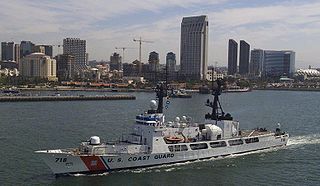
USCGC Chase (WHEC-718) was a Hamilton-class High Endurance Cutter of the United States Coast Guard. She was laid down on October 26, 1966, at Avondale Shipyards in New Orleans, launched on May 20, 1967, and commissioned on March 11, 1968. Chase is the fourth of twelve Hamilton class, 378-foot (115 m) cutters, and the third cutter named in honor of Salmon Portland Chase. She was decommissioned on March 29, 2011, and transferred to the Nigerian Navy as an excess defense article under the Foreign Assistance Act as NNS Thunder (F90).

The Hamilton-class cutter was the largest class of vessel in the United States Coast Guard until replaced by the Legend-class cutter, aside from the Polar-class icebreaker. The hull classification symbol is prefixed WHEC. The cutters are called the Hamilton class after their lead ship, or the "Secretary class" because most of the vessels in the class were named for former Secretaries of the Treasury, with the exception of the "Hero-class cutters" Jarvis, Munro and Midgett.
The history of the United States Coast Guard goes back to the United States Revenue Cutter Service, which was founded on 4 August 1790 as part of the Department of the Treasury. The Revenue Cutter Service and the United States Life-Saving Service were merged to become the Coast Guard per 14 U.S.C. § 1 which states: "The Coast Guard as established January 28, 1915, shall be a military service and a branch of the armed forces of the United States at all times." In 1939 the United States Lighthouse Service was merged into the Coast Guard. The Coast Guard itself was moved to the Department of Transportation in 1967, and on 1 March 2003 it became part of the Department of Homeland Security. However, under 14 U.S.C. § 3 as amended by section 211 of the Coast Guard and Maritime Transportation Act of 2006, upon the declaration of war and when Congress so directs in the declaration, or when the President directs, the Coast Guard operates as a service in the Department of the Navy.
The United States Coast Guard is the coastal defense, search and rescue, and maritime law enforcement branch of the United States Armed Forces and is one of the country's eight uniformed services. It carries out three basic roles, which are further subdivided into eleven statutory missions. The three roles are:

United States Coast Guard Cutter is the term used by the U.S. Coast Guard for its commissioned vessels. They are 65 feet (19.8 m) or greater in length and have a permanently assigned crew with accommodations aboard. They carry the ship prefix USCGC.

USCGC Hamilton (WHEC-715) was a United States Coast Guard high endurance cutter and the lead ship of its class. It was based at Boston, Massachusetts from commissioning until 1991, then out of San Pedro, California before it was moved to its last home port in San Diego, California. It was launched on December 18, 1965 at Avondale Shipyards near New Orleans, Louisiana and named for Founding Father Alexander Hamilton, the first United States Secretary of the Treasury and founder of the United States Revenue Cutter Service. It was commissioned on March 18, 1967.
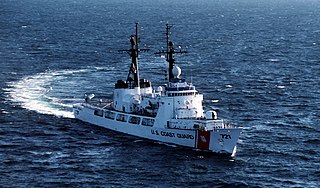
NNS Okpabana is a Hamilton-class high endurance cutter which formerly served with the U.S. Coast Guard as USCGC Gallatin (WHEC-721). Built at Avondale Shipyards near New Orleans, Louisiana, Gallatin was named for Albert Gallatin, the fourth and longest serving United States Secretary of the Treasury. Gallatin completed her final patrol 11 December 2013 and was decommissioned in 2014 before being transferred to the Nigerian Navy.
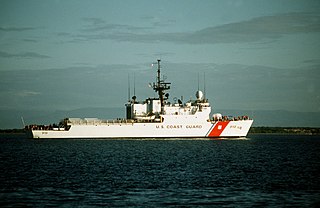
USCGC Thetis (WMEC-910) is a United States Coast Guard Famous-class medium endurance cutter. She is the 10th ship of the Famous Class cutters designed and built for the U.S. Coast Guard and the third Coast Guard cutter to bear the name. Laid down August 24, 1984 by Robert Derecktor Shipyard Incorporated of Middletown, Rhode Island. She was launched April 29, 1986 and named for the cutters USRC Thetis, which served from 1899 to 1916, and USCGC Thetis (WPC-115), which served from 1931 to 1947. The Greek goddess Thetis, incidentally, was the mother of Achilles. The Famous Class cutter Thetis was commissioned on June 30, 1989. She conducts patrols throughout the Caribbean and the Gulf of Mexico.

USCGC Spencer (WMEC-905) is a United States Coast Guard medium endurance cutter. Her keel was laid on 26 June 1982 at Robert Derecktor Shipyard Incorporated, Middletown, Rhode Island. She was named for John Canfield Spencer, United States Secretary of the Treasury from 1843 to 1844 under President John Tyler and launched on 17 April 1984 and was commissioned into service on 28 June 1986.

USCGC Seneca (WMEC-906) is a United States Coast Guard medium endurance cutter. Her keel was laid on September 16, 1982 at Robert Derecktor Shipyard Incorporated, Middletown, Rhode Island. She was launched June 16, 1984 and commissioned active August 4, 1986 and formally commissioned May 9, 1987. Her namesake is the first revenue cutter Seneca active from 1908–1936.

USCGC Escanaba (WMEC-907) is a United States Coast Guard medium endurance cutter based in Portsmouth, Virginia. Her keel was laid on April 1, 1983, at Robert Derecktor Shipyard Incorporated, Middletown, Rhode Island. She was launched February 6, 1985 and is named for her predecessor, USCGC Escanaba (WPG-77) which sank during World War Two, and was named for the Escanaba River and Escanaba, Michigan. Escanaba (WMEC-907) was formally commissioned August 29, 1987 in Grand Haven, Michigan, the home port of her predecessor.
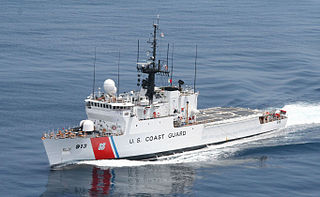
USCGC Mohawk (WMEC-913) is a 270' United States Coast Guard Famous-class medium endurance cutter. She was launched on September 9, 1989 at Robert Derecktor Shipyard Incorporated of Middletown, Rhode Island and commissioned in March 1991. She is the third cutter named for the Mohawk nation, a tribe of Iroquoian Indians from the Mohawk Valley of New York.

USCGC Bear (WMEC-901) is a United States Coast Guard medium endurance cutter. She was laid down August 23, 1979 and launched September 25, 1980 by the Tacoma Boatbuilding Company of Tacoma, Washington. She was commissioned February 4, 1983. She was named for USRC Bear (AG-29), a steam barquentine that was built in Scotland and served the United States Treasury Department in the United States Revenue Cutter Service's Alaskan Patrol.

SLNS Samudura (P621) is a Sri Lanka Navy Offshore Patrol Vessel. Originally commissioned by the United States Coast Guard in 1968 as the medium endurance cutter USCGC Courageous, she was donated to Sri Lanka in 2004 and commissioned on 19 February 2005.

USS Seize (ARS-26) was a Diver-class rescue and salvage ship commissioned in the United States Navy during World War II. Her task was to come to the aid of stricken vessels.
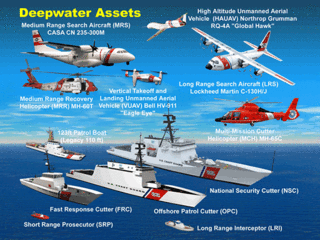
The Integrated Deepwater System Program was the 25-year program to replace all or much of the United States Coast Guard's equipment, including aircraft, ships, and logistics and command and control systems. The $24 billion program, which began with a price tag of $17 billion, lost authorization in Fiscal Year 2012 and is officially defunct.

USCGC Aspen (WLB-208) is the eighth cutter in the Juniper-class 225 ft (69 m) of seagoing buoy tenders. She is under the operational control of the Commander of the Eleventh U.S. Coast Guard District and is home-ported at Yerba Buena Island in San Francisco, California. Her primary area of responsibility is the coastal waters, river bars and high seas from the California–Oregon border to San Diego, California. Aspen conducts heavy lift aids-to-navigation operations, and law enforcement, homeland security, environmental pollution response, and search and rescue as directed.

USCGC Walnut (WLB-205) is the fifth cutter in the Juniper-class 225 ft (69 m) of seagoing buoy tenders and is the second ship to bear the name. She is under the operational control of the Commander of the Fourteenth Coast Guard District and is home-ported on Sand Island in Honolulu, Hawaii. Her primary area of responsibility is the coastal waters and high seas around the Hawaiian Islands and American Samoa. Walnut conducts heavy lift aids-to-navigation operations, and law enforcement, homeland security, environmental pollution response, and search and rescue as directed.

BRP Gregorio del Pilar (PS-15) is the lead ship of her class of offshore patrol vessel of the Philippine Navy. She is the second ship to be named after Gregorio del Pilar, a Filipino revolutionary general known for his role at the Battle of Tirad Pass. She was originally designated as "PF-15" from 2012 to mid-2016. Then the Navy adopted a new code designation system and she was redesignated as "FF-15". In February 2019, the Navy downgraded the status of the entire class from frigate to patrol ship and redesignated her to "PS-15".



















